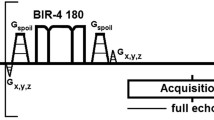Summary
In a series of 60 patients 62 intraoperative measurements with the 32-P (radiophosphorus) tumour marker were performed. Using miniature semiconductor probes a reliable discrimination between normal brain and neoplastic tissue was possible in nearly all brain tumours. The best results were found in meningiomas, where even small, visually hardly discernible tumour residues within the matrix zone could be reliably detected. Only in low-grade gliomas the application of the 32-P marker was impossible due to count rates similar to or below the basic rates of normal brain. This simple to use, noninvasive method proved its usefulness in all situations where a local radical tumour removal was important.
Similar content being viewed by others
References
Bullard DE, Bigner DD (1985) Applications of monoclonal antibodies in the diagnosis and treatment of primary brain tumors. J Neurosurg 63: 2–16
Chou SN, Aust JB, Peyton WT, Moore GE (1951) Radioactive isotopes in localization of intracranial lesions. Arch Surg 63: 554–560
Cramer H, Brilmayer C (1951) Verwendbarkeit von FluoresceinNatrium und Atebrin in der Tumordiagnostik. Münch Med Wschr 93: 2234–2238
Erf LA, Lawrence J (1941) Phosphorus metabolism in neoplastic tissues. Proc Soc Exp Biol Med 46: 664–695
Gamache FW, Galicich JH, Posner JB (1980) Treatment of brain metastases by surgical extirpation. In: Weiss L, Gilbert HA, Posner JB (eds) Brain metastases. G.K. Hall, Boston, Mass, pp 390–414
Goldhahn WW (1967) Tetracyclin-Fluoreszenz zur Abgrenzung von Hirntumoren. Arzneim Forschg 17: 139–141
Hevesy v G (1961) Radioisotope für Untersuchungen in Physiologie, Pharmakologie und Diagnostik. In: Schwiegk H (ed) Künstliche radioaktive Isotope. Springer, Berlin Göttingen Heidelberg, pp 536–570
King DL, Chang CH, Pool JL (1966) Radiotherapy in the management of meningeomas. Acta Radiol (Ther) Stockholm 5: 26–33
Maljarewsky A (1978) Vergleichsbeurteilung moderner Methoden der intraoperativen Diagnostik maligner Gliome des Gehirns. Zentralbl Neurochir 39: 91–96
Marshak A (1940) Uptake of radioactive phosphorus by nuclei of liver and tumors. Science 92: 460–461
Moore GE (1947) Fluorescein as an agent in the differentiation of normal and malignant tissues. Science 106: 130–131
Moore GE, Peyton WT, French LA, Walker WW (1948) The clinical use of fluorescein in neurosurgery. The localization of brain tumors. J Neurosurg 5: 392–398
Moore GE, Hunter SW, Hubbard TB (1949) Clinical and experimental studies of Fluorescein dyes with special reference to their use for the diagnosis of CNS-tumors. Ann Surg 130: 637–642
Murray KJ (1982) Improved surgical resection of human brain tumors. Part 1: a preliminary study. Surg Neurol 17: 316–319
Reinhardt H, Meyer H, Amrein E (1986) Computer aided surgery —Robotik für Hirntumoroperationen? Polyscope-Plus 5: 1–7
Reinhardt H, Meyer H, Amrein E (1988) A computer-assisted device for the intraoperative CT-correlated localization of brain tumors. Eur Surg Res 20: 51–58
Robinson CV, Selverstone B (1958) Localization of brain tumors at operation with radioactive phosphorus. J Neurosurg 15: 76–83
Roeder F (1940) 32-P im Nervensystem. Der Phosphataustausch des Nervensystems untersucht mit Hilfe der Isotopenmethode. Muster-Schmidt, Göttingen
Selverstone B, Sweet WH, Robinson CV (1949) The clinical use of radioactive phosphorus in the surgery of brain tumors. J Am Med Ass 140: 277–278
Selverstone B, White J (1951) Evaluation of the radioactive mapping technic in the surgery of brain tumors. Ann Surg 134: 387–396
Sorsby A, Wright DA, Ikeles A (1942) Vital staining in brain surgery. Proc Roy Soc Med 36: 137–140
Synowitz HJ (1987) Problem des Meningeom-Rezidivs. Zentrbl Neurochir 48: 186–193
Vogel S, Synowitz HJ, Lommatsch P, Thierfelder C, Correns HJ, Seidel G, Bartho H, Matauschek K, Scherd K (1979) Die klinische Anwendung von Halbleiterdetektorsonden. Dt Gesundh Wes 34: 1886–1892
Vogel S, Synowitz HJ (1981) Experimentelle Erprobung und klinische Anwendung von neuentwickelten Halbleiter-Detek-torsonden für die intraoperative Hirntumordiagnostik. Dissertation Humboldt-Universität DDR — Berlin
Wara WM, Sheline GE, Newman H (1975) Radiation therapy of meningeomas. Am J Roentgen 123: 453–458
Author information
Authors and Affiliations
Rights and permissions
About this article
Cite this article
Reinhardt, H. Surgery of brain neoplasms using 32-P tumour marker. Acta neurochir 97, 89–94 (1989). https://doi.org/10.1007/BF01772816
Issue Date:
DOI: https://doi.org/10.1007/BF01772816




